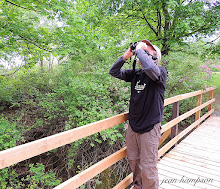Stepping down the stairs to the limestone shelf on the south-eastern edge of the park, we spotted a male Red-breasted Merganser in the water. One can usually find a few shorebirds in the pools as you walk towards the south shoreline but on this day, the birds were absent. Strong south-west winds created high waves on Lake Erie, reducing the beach as well as the number of shorebirds we encountered.
The high winds also made birding difficult when looking through the scope. Tilley hats not fastened down were soon flying off with birders in chase. I mimicked Jim Heslop and turned my OFO cap backwards to ensure it remained on my head.

Shorebirds added to the year list included, Semipalmated Sandpiper, Sanderling, Semipalmated Plover and Ruddy Turnstone. No dowitchers this time. No yellowlegs either. I spotted a peep with yellow legs before it disappeared behind some tall grass and informed Kevin that we may have a Least Sandpiper with the Semipalmated Sandpipers and Sanderlings. Though a Sanderling was determined to keep the smaller shorebirds away from the small area of mud, the bird returned and was identified as an adult Least Sandpiper. This was the only Least we found at Rock Point. Adult migration through southern Ontario started in late June and will soon end.

The Mozaic Evaporation Ponds north of Rock Point were the next planned stop. Normally the gates to the ponds are locked and views of the large pond are limited through a fence from the north side of Rymer Road. But being a member of the OFO has its privileges and during field trips birders are granted access to some of the finest evaporation ponds and sewage lagoons in Ontario. South of Rymer Road, the group walked along the dike that separates two ponds. Jean and I added Greater Yellowlegs to the year list at these ponds.
Reflecting on previous visits, the large pond north of the road is better for shorebirds. Lifers seen here include Stilt Sandpiper (#207) and Marsh Wren (#241). A raised laneway separates the pond into smaller pools and on a hot sunny day it can be quite grueling when walking from one end of the pond to the other. This day was pleasingly comfortable.

At the entrance, a Marsh Wren was singing in the reeds. Great Blue Heron were numerous and a very rough looking juvenile Black-crowned Night-Heron was seen flying over the pond. Shorebirds found here that were seen earlier, included Killdeer, Semipalmated Plover, Least Sandpiper, Lesser and Greater Yellowlegs and Semipalmated Sandpipers.
Jean and I added 2 more shorebirds to the year list while at this pond. 5 Short-billed Dowitchers were using their identifiable sewing-machine motion while foraging in the mud. There were 2 Pectoral Sandpipers present but only a select few (may be even less than that) were lucky enough to observe them before they disappeared. Though I needed Pectoral Sandpiper for the year list, the sting of the miss was soothed by the observation of another shorebird. A species that Jean and I observed for the first and only time in the fall of 2007 under the most unfavourable conditions of a thunderstorm. This day, the observation of a Red-necked Phalarope was a lot sweeter. All in the group had great views of the juvenile bird for at least 30 minutes. We left the phalarope still swimming in the shallows of the evaporation pond.

Our next stop was the local sod farms to observe plovers and hopefully, a Buff-breasted Sandpiper. At the first farm, no plovers. But the second was more fruitful. Among a large number of Killdeer, we observed 11 Black-bellied Plovers. Scanning the green of another farm produced an additional 6 Black-bellied. No Buff-breasted Sandpiper this trip. Even a distant Mourning Dove could not be transformed into the sought after shorebird.
After lunch, only 4 birders remained. Jean and I along with John Black and a birder from the Toronto area continued along the Erie shore into the western edge of the Niagara Region.
Morgan's Point was washed out and the quarry in Wainfleet produced Short-billed Dowitcher (5) and a Lesser Yellowlegs but no new shorebirds were added to the day's list.
During the Rock Point trip, 8 species were added to the year list. Only 23 ticks are now needed to reach 200. The week after the OFO trip, we had vacation plans in Bruce County. Not only was I looking forward to spending some time on the beach of Inverhuron with my brother-in-law's family, I was preparing to add ticks to the counties Jean and I travelled through. Yes, eBird Canada can now break down your provincial list into counties. So on August 15, Jean and I set out for the shores of Lake Huron. But before we could relax at the cottage, there was a bird we had to chase. A bird that has appeared on Ontbirds for the last few weeks and was conveniently located along our route to Inverhuron. There was no way I was letting this one slip by.







No comments:
Post a Comment